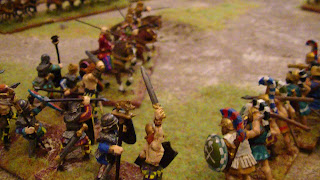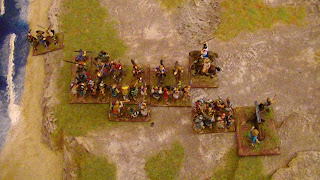 |
| The impressive Seleucid army |
The battle opposes the Greek army from Syracuse to the Seleucid army. The Greek is the attacker.
The game was played with the Big Battle DBA (BBDBA) rule with 36 bases per army.
The terrain chosen by the Seleucid player includes an arm of the sea, a river, two roads, some woods and a field, far from where the action will take place. A good part of the battlefield remains unobstructed in order to allow the loading of the chariots, elephants and knights, terrible weapons against which the Greek are well disarmed.
The row of poplars, along the road, is only decorative and will be removed if it is to generate the unfolding of the battle.
The game was played with the Big Battle DBA (BBDBA) rule with 36 bases per army.
The terrain chosen by the Seleucid player includes an arm of the sea, a river, two roads, some woods and a field, far from where the action will take place. A good part of the battlefield remains unobstructed in order to allow the loading of the chariots, elephants and knights, terrible weapons against which the Greek are well disarmed.
The row of poplars, along the road, is only decorative and will be removed if it is to generate the unfolding of the battle.
 |
| Greek army |
The Greek general has opted for a particular deployment. Fearing the strike force of the Seleucids, he abandoned the center of the battlefield. Supporting his defensive strategy on a wood and river, to the right of the battlefield. On the other hand, a more aggressive corps is destined to go along the coast and throw itself on the Seleucid right in order to preserve the initiative on one of the battlefield points.
Celtic mercenaries having abused the pint on the preceding vigil, the Greek general thinks it more prudent to leave them in the boats and to disembark them when they have desolated. What Seleukos does not know.
Celtic mercenaries having abused the pint on the preceding vigil, the Greek general thinks it more prudent to leave them in the boats and to disembark them when they have desolated. What Seleukos does not know.
 |
| Seleucid right wing |
The Seleucid cavalry is assembled on the right wing of the army in three successive waves. The light riders (LH) at the head, followed by the riders (Cv), themselves pressed by the cavalry of shock (Kn). As the BBDBA rules allow, the subordinate generals have dismounted to fight feet, at the head of the phalanges. The platelets of Kn pass under the direct command of Seleukos, the general in chief
 |
| Left extremity of the Greek right wing. |
 |
| The Greek right wing rests on the river |
Worried by the presence of the numerous elephants (6 pads, the sixth of the enemy's army!) And the chariots, the Greek general left two pieces of riveting close to one another so that their shots could, If necessary, to support each other.
Seleukos, launched his army on the whole line of battle. The effort is accentuated on his right wing, where his cavalry manages it very quickly reaches near the Greek ranks.
 |
| The surprise landing of the Gauls. |
The poker stroke of the Greek general then occurs. Celtic mercenaries emerged from the boats, much to the surprise of the Seleucids. (The Greek being the attacker, the platelets appear at the beginning of his first tale ... after the first Seleucid movement)
They quickly engage the enemy light riders on the beach. The struggle is desperate on both sides, the Celts risking a drowning assured if they are repulsed and the recoil of light riders caught flank being generated by their companions.
They quickly engage the enemy light riders on the beach. The struggle is desperate on both sides, the Celts risking a drowning assured if they are repulsed and the recoil of light riders caught flank being generated by their companions.
The Greek horsemen rush into no man 's land in the center of the battlefield, in order to be able to slow down the bulk of the Seleucid forces.
The Celtic mercenaries manage to set foot on the mainland. The situation becomes critical for Seleucid light riders.
View of the landing from the Greek ship (the photo allows me to notice that I have a lance to paint ^^)
The Seleucid heavy cavalry sprang to the rescue of its isolated companions, lifting a thick cloud of smoke over the plain.
Too isolated, the light cavalry is annihilated before the arrival of this late support. It is attacked from the front by the hoplites and taken by flank by the Celtic mercenaries and a unit of light Greek riders who have detached themselves from their companions guarding the center of the battlefield.
In the shelter of the river, the Greek army is advancing. The hoplites rush to keep the bridge, the artillery is reoriented to support the troops who have remained on the other side, while the cavalry and the psilois go straight ahead in search of a fordable passage well beyond The Seleucid line.
The Seleucid heavy cavalry, arrived too late to support its light troops, is, in turn, stuck in the Greek line.
 |
| Séleukos and his heavy shock cavalry |
Seleukos and the Cavalry of Shock observe from the third line, the assault of the heavy cavalry. A chariot and phalanges are sent in support in order to avoid asphyxiation of the riders, attacked from all sides.
The Seleucid heavy cavalry is annihilated.
 |
| Right extremity of the Greek left wing. |
In the center of the battlefield, the Greek horsemen do not make the weight and fail to retain as much as they wanted the enemy line. They then retreated to lean on the right extremity of the left wing of their army. The Seleucid warriors hit hard on the hoplites present in this area of the battlefield.
The bridge over the river is in under hoplites' control.
 |
| Seleucid left wing bypass |
Note: lacking Greek heavy riders, these bases are represented by Gallic mercenary horsemen, which comes to the same n term of play and is not historically shocking for an army of Syracuse.
Having no cavalry on its left wing, the Seleucid can send as fast troops only slingers in order to desperately attempt to cut the road of the camp to the skirmishers and the Greek cavalry.
The hoplites abandoned the bridge to throw themselves on the exposed side of the Seleucids, the artillery having shot down one of the most menacing elephants.
Against any prognosis and probability, the Seleucid slingers blocked the enemy advance towards their encampment. Their heroism even saves enough time to allow a heavy chariot to come to support.
The wing of Seleucid cavalry, demoralized and largely destroyed, is on the run. The Greek general succeeded in reorganizing his troops patiently so as to remain in order for the priest who was preparing against the Seleucid center, which was very powerful but heavy and not very manoeuvrable.
A critical moment for the Seleucid slingers blocking the road to the camp. They will survive this episode and will repel their opponents (again against any probability ^^)
The Ligurian and Iberian mercenaries of Syracuse hold the wood on which the Greek right wing rests and neutralizes an important enemy strike force.
The heroic defense stood firm and the road to the Seleucid camp is now cut off for the Greek general.
On the other hand, on the battlefield rises, the losses are too great for the Seleucids and the army, demoralized, runs away.
The victory came to the Syracusans.
The only consolation for Seleukos: after saving the encampment, the slingers succeeded in rejecting the Greek general to the river, and it was by retreating, from the water to the waist, that he attended the victory of his army and To the Seleucid rout.
In terms of game, the victory is very important, the Greek player having lost only 3 pads out of the 36 engaged. Viewing the power of the Seleucid army this was very unexpected (and does not reflect the battle, where things were not so decided)
As part of our "championship" internal to the player group, the scores obtained are 71 to 3. Which is, at this time of the championship the largest score.
(72 kills, the Seleucid kills three> 3 pts, so the Greek has 72-3 = 69 points + 2 bonus points for killing one of the three enemy generals)





























